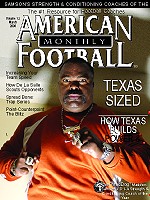AMERICAN FOOTBALL MONTHLY THE #1 RESOURCE FOR FOOTBALL COACHES
Article CategoriesAFM Magazine
|
The Need for Speedby: Richard Scott© More from this issue From the time young football players figure out they’re faster than the other players on the field, many assume speed is simply a gift that some have, some don’t. They figure it’s all a matter of nature, genetics or a divine blessing. While it’s true that some young men are simply born and raised faster than others, no football player has to be content with his speed – or his lack of speed. “A lot of the kids we recruit have a lot of untapped potential. They’re late bloomers, a kid who isn’t quite a Division I-A athlete,” said Eric Klein, the strength and conditioning coach at Southern Illinois University. “We put them through a lot of hard work and mechanics and show them that they can be faster. Now that we’ve been here a few years, the proof is in the pudding. “When ....The full article can only be seen by subscribers. Subscribe today!
|
|
|||||||
| HOME |
MAGAZINE |
SUBSCRIBE | ONLINE COLUMNISTS | COACHING VIDEOS |
Copyright 2025, AmericanFootballMonthly.com
All Rights Reserved





